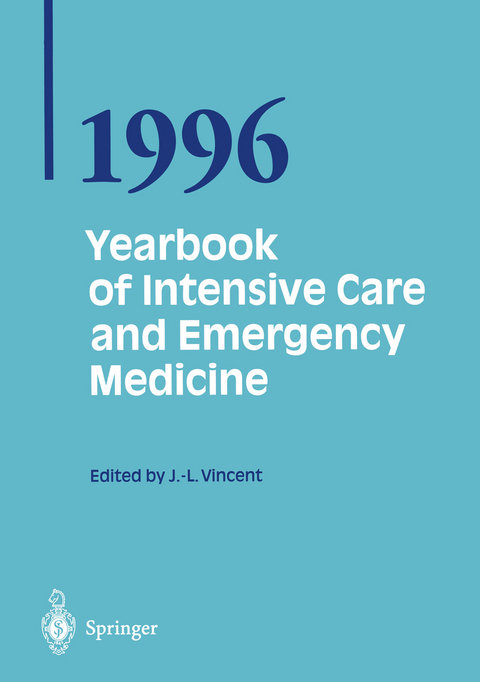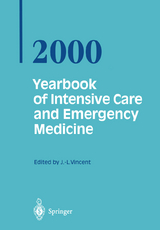
Yearbook of Intensive Care and Emergency Medicine
Springer Berlin (Verlag)
978-3-540-60552-2 (ISBN)
Sepsis.- Sepsis and Inflammation: The Process of Dying from Critical Illness.- Recognition of Bacteria and Bacterial Products by Host Immune Cells in Sepsis.- Endotoxin Immune Status and Protection Against Multiple Organ Dysfunction Syndrome in the Surgical Patient.- Cardiovascular Function in Septic Shock.- Changes in Cardiac Signal Transduction in Septic Shock.- Recent Advances in the Hemodynamic Therapy of Septic Shock.- Immunotherapy.- Cytokine Gene Polymorphism in Infectious and Inflammatory Diseases.- Neutrophil-induced Oxidative Stress.- Antioxidant Therapy in Critical Illness.- Interleukin-10 Production during Septic Shock.- Potential Role for Human Interleukin-11 in Bacterial Sepsis.- Cellular Response to Inflammation and its Antagonism by ?2-Adrenoceptor Agonists.- Sepsis Treatment and Prophylaxis with Immunoglobulins: A Critical Appraisal.- Low Dose G-CSF to Augment Host Defense and Counteract Progression in Sepsis.- Rethinking the Anti-Inflammatory Approach to Septic Shock.- Immunotherapy of Severe Sepsis and Septic Shock: Is there a Future?.- Gut Dysfunction.- Intestinal Ischemia/Reperfusion: A Role for Mast Cells and Neutrophils.- Bacterial Translocation: Cause or Effect of Multiple Organ Failure?.- Gut Oxygenation after Reduced Oxygen Delivery.- Peri-Operative Gastrointestinal Tonometry.- Prokinetic Use to Facilitate Enteral Feeding.- Early Postinjury Enteral Nutrition: Does it make a Difference?.- Oxygen Availability.- The Cell, the Mitochondrion, Oxygen and Sepsis.- The Role of Microcirculation in Sepsis.- Sepsis, Anemia, and Tissue O2 Availability.- Critical Analysis of Venoarterial CO2 Gradient as a Marker of Tissue Hypoxia.- Does Cardiovascular Optimization Reduce Mortality?.- Hepato-splanchnic Blood Flow.- Pressure-Flow Relationships in LiverVascular Beds during Sepsis.- ?-Adrenergic Drugs to improve Gastrointestinal Mucosal Blood Flow in Sepsis.- Role of Nitric Oxide.- Role of Nitric Oxide in the Pathogenesis of Gram-Positive Shock.- Nitric Oxide Involvement in Septic Shock: Do Human beings behave like Rodents?.- Nitric Oxide: Effects on the Airways.- Respiratory Failure.- A Broader View of ARDS.- Strategies to minimize Alveolar Stretch Injury during Mechanical Ventilation.- Lung Protective Ventilatory Strategies in ARDS.- Positive End-Expiratory Pressure and Permissive Hypercapnia in ARDS.- Methods to improve Matching between Ventilation and Perfusion during Ventilatory Support in ARDS.- Pharmacologic Approach of Hypoxemia in ARDS Patients.- Airflow Obstruction.- Management of Life-Threatening Airflow Obstruction.- Airway Resistance and Bronchodilator Responsiveness in ARDS.- Mechanical Ventilation.- Conditioning of Air in Mechanically Ventilated Patients.- New Histopathological Aspects of Human Ventilator-Associated Pneumonia.- Infectious Vignettes.- Necrotizing Fasciitis.- Acinetobacter Infections in Intensive Care Units.- Fungal Infections.- Fungal Infection in the Organ Transplant Recipient: Challenges and Opportunities.- When to Start Antifungal Therapy in the Non-Neutropenic Critically Ill?.- Cardiovascular Failure.- Hemorrhage and Injury: Cardiovascular and Regional Blood Flow Responses.- Myocardial Ischemia.- Detection of Myocardial Viability and Inducible Ischemia with Dobutamine.- Continuous Electrocardiographic Monitoring for Myocardial Ischemia.- Do ACE Inhibitors have a Place in the Critically Ill?.- Hematologic Failure.- Critical Hematocrit.- Acquired Coagulopathies.- Liver Failure.- Acetaminophen Overdose and Acute Liver Failure: Modern Management.- Kidney Failure.- Renal Rescue:Management of Impending Renal Failure.- Continuous High Flux Dialysis: An Efficient Renal Replacement.- Brain Failure.- Non-traumatic Coma and Status Epilepticus in Infants and Children.- Guidelines for Management of Severe Head Injury in Adults.- Goal-Directed Therapy in Neurotrauma.- How to Interpret Jugular Bulb Oximetry.- New Treatment Modalities to Improve Outcome after Subarachnoid Hemorrhage.- Analgesia and Sedation.- Pain Measurement in Children.- Pharmacokinetics and Drug-Protein Binding.- Emergency Medicine.- The Role of Emergency Medical Services in Mass Casualties.- Overview of 10 Years (1983-1992) of Poisoning Data.- Resuscitation.- Resuscitation Decisions.- Active Compression-Decompression Resuscitation.- Outcome Prediction.- Customized Probability Models for Early Severe Sepsis in Adult Intensive Care Patients.- Neural Networks: A New Tool for Predictive Models.- Today and Tomorrow.- Expanding the Role of Intensive Care Medicine.- Internet as a New Source of Information in the Intensive Care Field.
| Erscheint lt. Verlag | 11.3.1996 |
|---|---|
| Reihe/Serie | Yearbook of Intensive Care and Emergency Medicine |
| Zusatzinfo | XXIII, 858 p. 45 illus. |
| Verlagsort | Berlin |
| Sprache | englisch |
| Maße | 170 x 242 mm |
| Gewicht | 1491 g |
| Themenwelt | Schulbuch / Wörterbuch ► Lexikon / Chroniken |
| Medizin / Pharmazie ► Medizinische Fachgebiete ► Anästhesie | |
| Medizinische Fachgebiete ► Innere Medizin ► Kardiologie / Angiologie | |
| Medizin / Pharmazie ► Medizinische Fachgebiete ► Intensivmedizin | |
| Medizin / Pharmazie ► Medizinische Fachgebiete ► Notfallmedizin | |
| Schlagworte | anesthesia • Care • Emergency Medicine • Intensive care • Intensivpflege • Internal Medicine • Notfallmedizin • Notfallmedizin / Akutmedizin • Surgery |
| ISBN-10 | 3-540-60552-5 / 3540605525 |
| ISBN-13 | 978-3-540-60552-2 / 9783540605522 |
| Zustand | Neuware |
| Haben Sie eine Frage zum Produkt? |
aus dem Bereich



